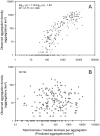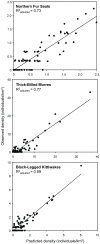Prey patch patterns predict habitat use by top marine predators with diverse foraging strategies
- PMID: 23301063
- PMCID: PMC3536749
- DOI: 10.1371/journal.pone.0053348
Prey patch patterns predict habitat use by top marine predators with diverse foraging strategies
Abstract
Spatial coherence between predators and prey has rarely been observed in pelagic marine ecosystems. We used measures of the environment, prey abundance, prey quality, and prey distribution to explain the observed distributions of three co-occurring predator species breeding on islands in the southeastern Bering Sea: black-legged kittiwakes (Rissa tridactyla), thick-billed murres (Uria lomvia), and northern fur seals (Callorhinus ursinus). Predictions of statistical models were tested using movement patterns obtained from satellite-tracked individual animals. With the most commonly used measures to quantify prey distributions--areal biomass, density, and numerical abundance--we were unable to find a spatial relationship between predators and their prey. We instead found that habitat use by all three predators was predicted most strongly by prey patch characteristics such as depth and local density within spatial aggregations. Additional prey patch characteristics and physical habitat also contributed significantly to characterizing predator patterns. Our results indicate that the small-scale prey patch characteristics are critical to how predators perceive the quality of their food supply and the mechanisms they use to exploit it, regardless of time of day, sampling year, or source colony. The three focal predator species had different constraints and employed different foraging strategies--a shallow diver that makes trips of moderate distance (kittiwakes), a deep diver that makes trip of short distances (murres), and a deep diver that makes extensive trips (fur seals). However, all three were similarly linked by patchiness of prey rather than by the distribution of overall biomass. This supports the hypothesis that patchiness may be critical for understanding predator-prey relationships in pelagic marine systems more generally.
Conflict of interest statement
Figures




Similar articles
-
Nocturnal Foraging by Red-Legged Kittiwakes, a Surface Feeding Seabird That Relies on Deep Water Prey During Reproduction.PLoS One. 2015 Oct 14;10(10):e0138850. doi: 10.1371/journal.pone.0138850. eCollection 2015. PLoS One. 2015. PMID: 26465335 Free PMC article.
-
Foraging responses of black-legged kittiwakes to prolonged food-shortages around colonies on the Bering Sea shelf.PLoS One. 2014 Mar 26;9(3):e92520. doi: 10.1371/journal.pone.0092520. eCollection 2014. PLoS One. 2014. PMID: 24671108 Free PMC article.
-
Fortuitous encounters between seagliders and adult female northern fur seals (Callorhinus ursinus) off the Washington (USA) coast: upper ocean variability and links to top predator behavior.PLoS One. 2014 Aug 25;9(8):e101268. doi: 10.1371/journal.pone.0101268. eCollection 2014. PLoS One. 2014. PMID: 25153524 Free PMC article.
-
Cascading top-down effects of changing oceanic predator abundances.J Anim Ecol. 2009 Jul;78(4):699-714. doi: 10.1111/j.1365-2656.2009.01531.x. Epub 2009 Mar 9. J Anim Ecol. 2009. PMID: 19298616 Review.
-
Functional responses and scaling in predator-prey interactions of marine fishes: contemporary issues and emerging concepts.Ecol Lett. 2011 Dec;14(12):1288-99. doi: 10.1111/j.1461-0248.2011.01696.x. Epub 2011 Oct 11. Ecol Lett. 2011. PMID: 21985428 Review.
Cited by
-
Harnessing a mesopelagic predator as a biological sampler reveals taxonomic and vertical resource partitioning among three poorly known deep-sea fishes.Sci Rep. 2023 Sep 26;13(1):16078. doi: 10.1038/s41598-023-41298-9. Sci Rep. 2023. PMID: 37752192 Free PMC article.
-
The Argos-CLS Kalman Filter: Error Structures and State-Space Modelling Relative to Fastloc GPS Data.PLoS One. 2015 Apr 23;10(4):e0124754. doi: 10.1371/journal.pone.0124754. eCollection 2015. PLoS One. 2015. PMID: 25905640 Free PMC article.
-
Using pseudo-absence models to test for environmental selection in marine movement ecology: the importance of sample size and selection strength.Mov Ecol. 2022 Dec 29;10(1):60. doi: 10.1186/s40462-022-00362-1. Mov Ecol. 2022. PMID: 36581885 Free PMC article.
-
Blue whales increase feeding rates at fine-scale ocean features.Proc Biol Sci. 2022 Aug 31;289(1981):20221180. doi: 10.1098/rspb.2022.1180. Epub 2022 Aug 17. Proc Biol Sci. 2022. PMID: 35975432 Free PMC article.
-
Remote sensing of zooplankton swarms.Sci Rep. 2019 Jan 24;9(1):686. doi: 10.1038/s41598-018-37129-x. Sci Rep. 2019. PMID: 30679810 Free PMC article.
References
-
- Krebs JR (1978) Optimal foraging: Decision rules for predators. In: Krebs JR, Davies NB, editors. Behavioural Ecology, an Evolutionary Approach. Sunderland, MA: Sinauer. 23–63.
-
- Fretwell SD, Lucas HL (1970) On territorial behaviour and other factors influencing habitat distribution in birds. I. Theoretical development. Acta Biotheor 19: 16–36.
-
- Barnett A, Semmens JM (2012) Sequential movement into coastal habitats and high spatial overlap of predator and prey suggest high predation pressure in protected areas. Oikos 121: 882–890.
-
- Wirsing AJ, Cameron KE, Heithaus MR (2010) Spatial responses to predators vary with prey escape mode. Anim Behav 79: 531–537.
-
- Lima SL (2002) Putting predators back into behavioral predator-prey interactions. Trends Ecol Evol 17: 70–75.
Publication types
MeSH terms
LinkOut - more resources
Full Text Sources
Other Literature Sources

